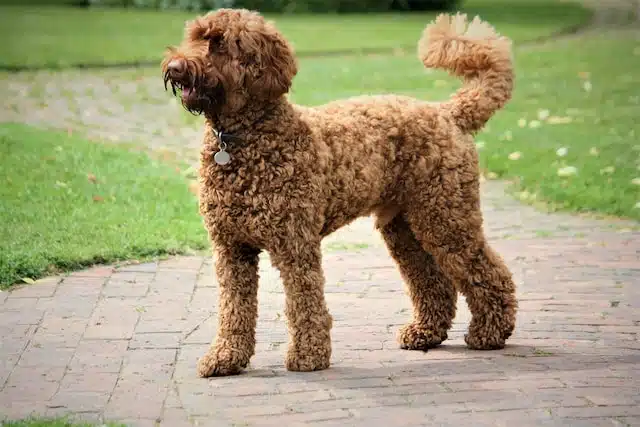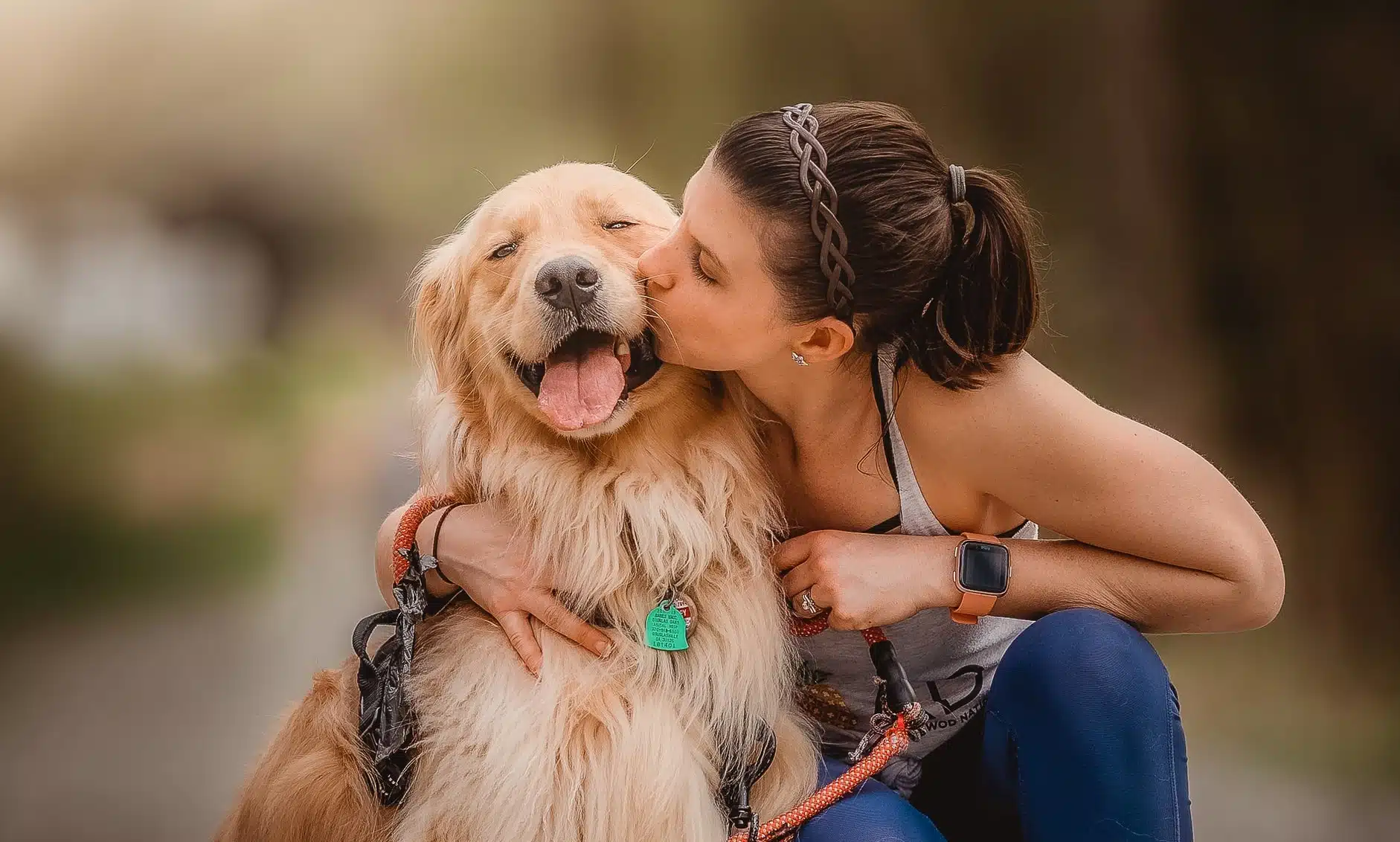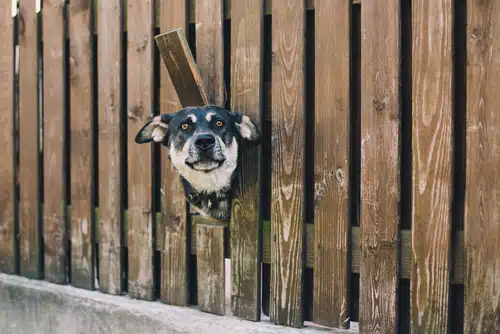Home » Blog » Pet » Pet Parenting Lifestyle » Labradoodle VS Cobberdog: Puppies, Prices and More
Categories
Tags
animal welfare
breed profile
buying a car
buying a pet
Car
car accessories
car care
car features
car insurance
Car safety
car sales
car service
cat
cat behaviour
cat body language
Cat Breeds
cat food
cat insurance
comprehensive car insurance
Dog
Dog Behaviour
dog body language
Dog Breeds
dog food
Dog Insurance
dog training
eco friendly cars
Kitten
New Car
pet accessories
pet activities
Pet Adoption
pet breeders
pet days of the year
pet fun stuff
Pet Health
pet insurance
pet parenting
Pet Safety
pet services
Puppy
rescue pets
road safety
road trip
safe driving
Recent Blog:
Facebook Posts
1 day ago
True or false: A stiff brake pedal can stop your car from starting? Answers here…![]()
![]() 3 Reasons For a Stiff Brake Pedal and Car That Won't Start –
... See MoreSee Less
3 Reasons For a Stiff Brake Pedal and Car That Won't Start –
... See MoreSee Less
3 Reasons for a Stiff Brake Pedal and Car That Won't Start
www.pd.com.au
Help! My car isn't starting and the brake pedal is stiff - why?! First of all, if your brake is stiff and car won't start then you've already pieced3 days ago
Growing old sometimes means we can’t take care of pets anymore. Find out some advice on what to do when this happens:![]()
![]() Senior Pet Parents – Contingency Plans for Your Pet –
... See MoreSee Less
Senior Pet Parents – Contingency Plans for Your Pet –
... See MoreSee Less
Senior Pet Parents' Contingency Plans for Pets
bit.ly
Sometimes senior pet parents need more downtime. For older pet owners, this can be tricky to navigate if their dog or cat is full of beans and wants to5 days ago
Celebrating World Vet Day by expressing our gratitude to all the wonderful vets out there! You're the real heroes for our fluffy companions. #WorldVetDaye#ThankYouVetsu#PDPetsdpets
... See MoreSee Less
Ever heard of the Australian Cobberdog? Did you know it’s one of our very own types of Labradoodle? That’s just one of the MANY fantastic facts about Labradoodle puppies and adult dogs. This dog breed ticks so many boxes for pet lovers, from allergy friendly(ish) fur to a delightful blend of breed ancestors, cuteness off the radar and much more.
In this article, PD Insurance answers some top questions about the Labradoodle, including why it’s sometimes called a Cobberdog. Let’s get doodlin’!
In this article
- What are Labradoodles?
- What are the different types of Labradoodles?
- Is a Cobberdog the same as a Labradoodle?
- How much are Australian Cobberdogs?
- Is a Labradoodle a good family dog?
- Doggy DNA
- Do Labradoodles shed?
- Are Labradoodles hypoallergenic?
- Is a Labradoodle a high maintenance dog?
- Average life span?
- How much for a Labradoodle puppy?
- Award winning dog insurance
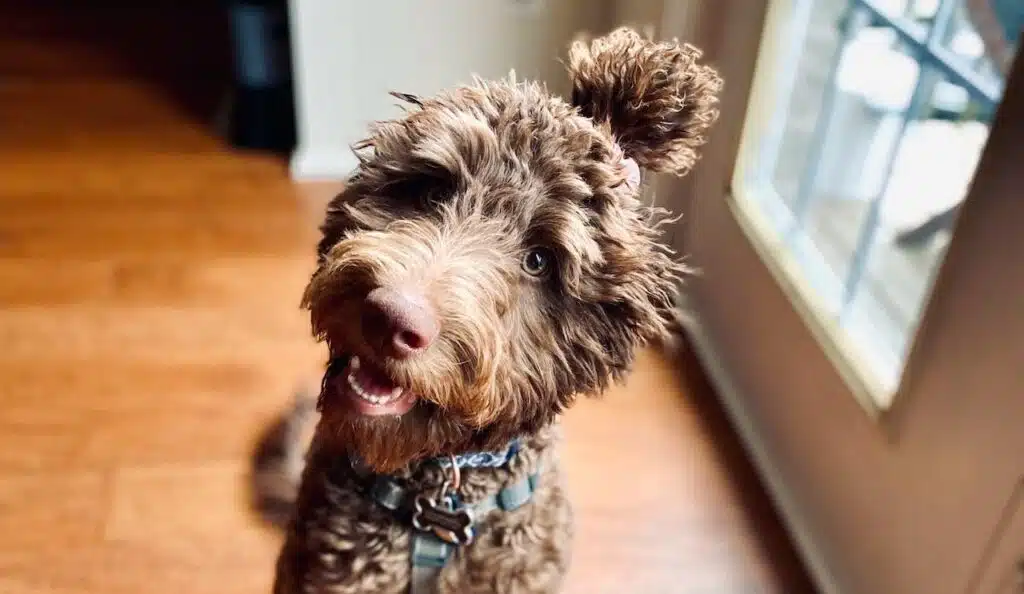
What are Labradoodles?
The Labradoodle is a type of hybrid dog whose family genes come mainly from the Labrador Retriever and the Poodle. These two dogs can make for a great mix because they’re both very intelligent and highly trainable. In addition, the Poodle is famous for having hair that doesn’t cause as many allergies as fur.
In addition to having Poodle and Labrador genealogy, your average Labradoodle puppy may also have a blend of DNA across Cocker Spaniels, Irish Water Spaniels and Irish Terriers.
What are the different types of Labradoodles?
There seems to be a bit of confusion when it comes to Labradoodles and that’s no surprise. Though the name Labradoodle brings to mind a cute curly haired friendly dog there are actually several types.
Here’s a quick look at what these are:
- Australian Labradoodle
- Australian Cobberdog
- American Labradoodle
Why the difference? As with many dogs, it’s all in the genes. Let’s take a look.
Hybrid dogs explained
Hybrid dogs, also sometimes called designer dogs, tend to be a mix of two or more recognised dog breeds. In other words, they’re designer blends. Because pedigree dogs take many generations of careful breeding to become recognised by kennel clubs as purebred dogs, designer dogs don’t have purebred dog status.
That’s why, along with the Cavoodle and Spoodle, the Labradoodle isn’t recognised by any major kennel club. However, the Australian Labradoodle is part of the DNA of the Cobberdog, which is on its way to becoming a recognised purebred dog.
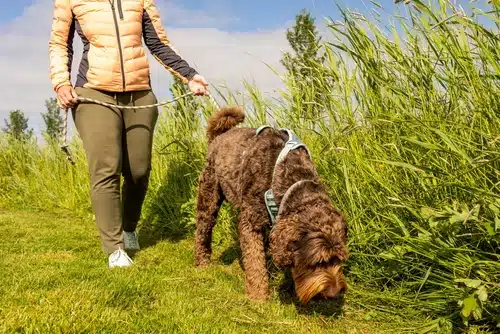
Is a Cobberdog the same as a Labradoodle?
Although the Australian Cobberdog is (or was/comes from) a type of Labradoodle, it’s a bit different. Unlike many Labradoodles, the Australian Cobberdog is considered a purebred pedigree in development, something that neither the Australian nor American Labradoodle is.
Speaking of which, all pedigree dogs are purebred but not all purebreds are pedigrees (read pedigree vs purebred to find out why).
Australian Labradoodle VS Cobberdog
Different to the Australian Labradoodle, the Cobberdog is bred to strict breeding criteria so that breed characteristics are genetically stable and can be passed along from parent to puppies.
Labradoodles, regardless of which country they come from, aren’t always the exact same mix of dogs so the Labradoodle puppy can vary in temperament and appearance from its mum and dad and littermates.
Even though the Australian Cobberdog is a type of Labradoodle, the word ‘Labradoodle’ isn’t part of its official name. That’s because the Australian Labradoodle was used as part of the Cobberdog’s original breed makeup but since then the breed’s DNA has been under strict watch to ensure there’s breed consistency.
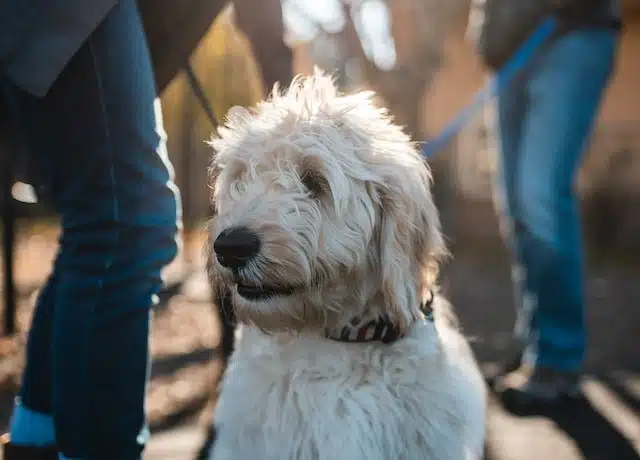
How much are Australian Cobberdogs?
If you’re looking to buy an Cobberdog, you may need to save a bit more than if you were to become the proud parent of an Australian Labradoodle. Naturally, the breeding of any dog that’s being carefully developed to meet all the breed characteristics takes time, knowledge and care.
While prices may vary from one breeder to another and may depend on availability, you can buy an Australian Cobberdog for around $5,500. Scroll down for more on the price of Labradoodles.
Is a Labradoodle a good family dog?
Given its DNA, the Labradoodle is often considered a lovely family dog that’s friendly and full of energy. But it’s important to bear in mind that, just like people, every Labradoodle is unique.
For example, Poodles sometimes aren’t considered the best of dogs for families with small children, whereas Labrador Retrievers are. Both these dogs are part of the Labradoodle dog’s DNA so it can go either way or end up being a complete combo of both.
Every Labradoodle dog is unique
Because of the many other dog breeds that may be mixed in with a Labradoodle’s DNA, each dog can have a unique colour, coat and temperament. Generally speaking, this dog is considered to be friendly, fun, intelligent and great to train.
Assistance, therapy and emotional support dogs
Labrador Retrievers are considered the world’s #1 assistance dog breed. Poodles are also on the list of good assistance dogs. As a result, Labradoodles can have a penchant for learning to do tasks and they’re great fun to be around.
Find out the difference is between an assistance, therapy or emotional support dog.
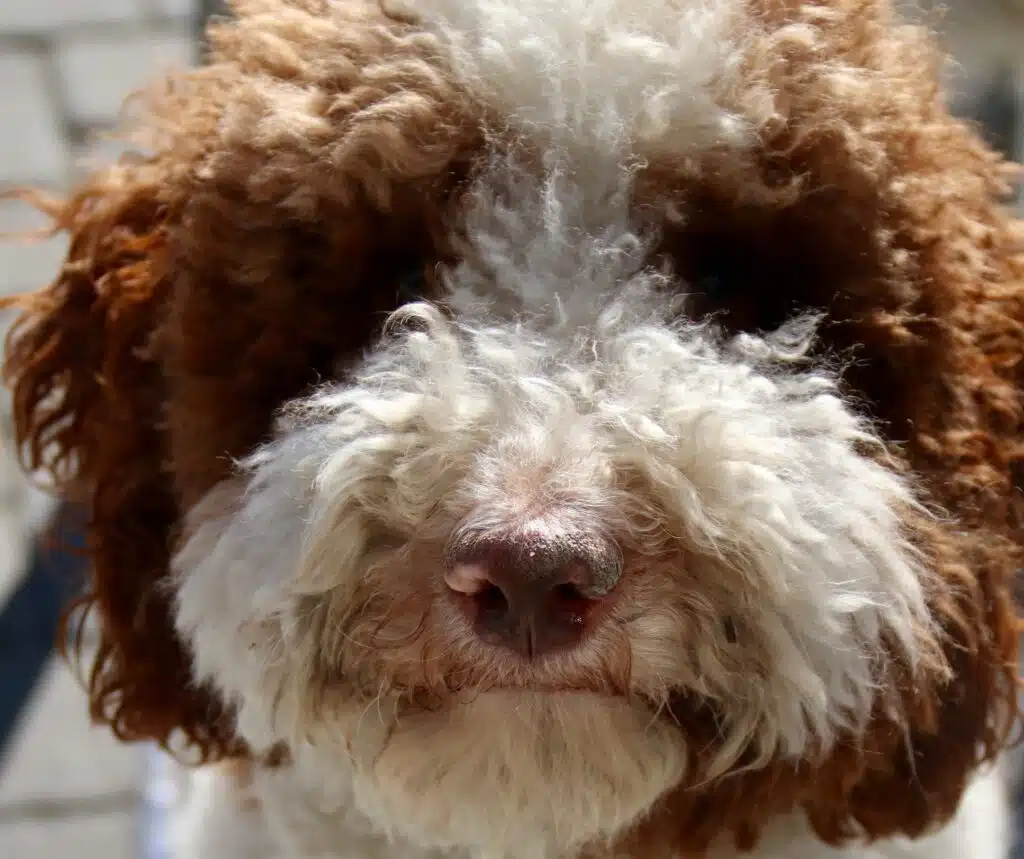
Doggy DNA
We’ve already mentioned where the Labradoodle gets its good looks and personality from. But besides its genetic makeup, did you know there are also different generations of the breed?
Here’s a quick look at how this works:
- First generation (F1). A first gen dog is a mix of a purebred Labrador Retriever and purebred Poodle.
- Second generation (F1B). A mix of first generation Labradoodle with a Labrador Retriever or Poodle.
- Multigenerational. Dogs bred from two or more generations of Labradoodles.
The multigenerational Labradoodle puppy is the most common version. Interestingly these dogs are known for shedding less than first and second generation Labradoodles.
Do Labradoodles shed?
Although they may shed a little less than dogs without Poodle DNA, it’s a maybe rather than a definite. You may find your little Labradoodle puppy grows up to shed just as much as every other dog.
The best thing you can do is have a regular grooming schedule. It’s a nice way to reduce the fluff from flying around the home and to spend quality time with your dog.
Grooming
Here are the steps to grooming your Labradoodle dog’s lovely locks and more:
- Brush regularly. Regular brushing helps you avoid tangled masses of matted hair!
- Bath time. Happily, you can get away with a good bath once every four weeks.
- Eyes. Wipe away any discharge from your pup’s eyes with a damp cloth to prevent irritation.
Find out more about routine pet care and how to choose a good dog groomer if you want a professional touch. Also keep in mind that, like all dogs, your Australian Cobberdog or Labradoodle can be prone to dog ear infections so keep those ears clean and dry.

Are Labradoodles hypoallergenic?
Just like its personality, each Labradoodle puppy or dog can have differences in their fur. Generally speaking, they have a higher likelihood of causing fewer allergies because of their Poodle inheritance. As a result, these dogs are sometimes sold as ‘hypoallergenic dogs.’
Poodles and some other dog breeds born with hair rather than fur tend not to shed or shed much less. Hair tends to keep growing until it’s trimmed whereas fur grows to a set length before shedding.
However, it’s important to keep in mind there’s no guarantee of exactly what ratio of the blend of parents a Labradoodle dog has or how well managed the breeding is, so there’s also no guarantee your hybrid dog won’t cause allergies.
Is a Labradoodle a high maintenance dog?
While Labradoodles are highly trainable, achieving successful results demands considerable patience and consistency. You’ll need to make sure you have the right amount of time and energy to invest in their training.
Keep in mind Labradoodles that don’t get the appropriate training and socialisation can develop of behavioural issues just like any other dog.
These dogs thrive on social interactions and find it challenging to cope with extended periods of solitude. If you have a demanding work schedule or frequently travel, Labradoodles may not be the ideal breed for your lifestyle. It’s important to avoid separation anxiety in pets by matching their needs and your lifestyle.
Wondering if you should get a dog if you work full time? Then read about how long is too long to leave a dog home alone.

Average life span?
If you feed your dog a nutritionally balanced diet and keep them well exercised they could live a happy, healthy life extending over a decade. Here’s more about the average Labradoodle lifespan and other fast facts:
| Average life span | 12 – 15 years |
| Size | Standard, Medium and Miniature |
|---|---|
| Height at shoulder | Standard, 56 – 61 cm / Medium, 46 – 51 cm / Miniature, 36 – 41 cm |
| Weight | Standard, 23-29 kg / Medium, 14-20 kg / Miniature, 7-11 kg |
| Coat type | Wavy to curly |
| Coat colours | Caramel, black, chocolate, gold/apricot, cream, red and others! |
How much for a Labradoodle puppy?
A Labradoodle puppy in Australia costs around $3,500 to $4,000 (at the time of writing). As with the Australian Cobberdog, the price will likely vary depending on which breeder you buy your dog from… or whether you adopt one.
Here’s more on bringing home an adopted dog along with our dog adoption checklist.
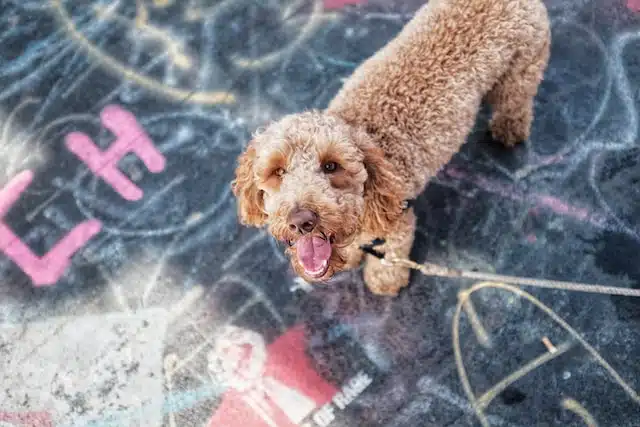
Award winning dog insurance
Both the Labradoodle and its pedigree pal the Australian Cobberdog can be prone to genetic health conditions that are common in Labradors or Poodles. This includes conditions like hip dysplasia in dogs and eye conditions.
Responsible breeding for health
One reason it’s so important to find an ethical dog breeder is they’re more likely to do genetic tests that help mitigate the passing on of certain genetic health conditions. This can help your Labradoodle puppy live a long happy life and even go some way towards reducing the likelihood of behavioural conditions springing up.
Pet insurance is a safety net for pets and pockets
Regardless of how healthy any pet is, it’s a good idea to have pet insurance in place as a safety net. Having dog insurance can help pay towards the costs of surgery, X-rays, bloodwork, hospitalisation, stayovers at the vet clinic and much, much more.
PD Insurance gives you one or more months of FREE pet insurance when you buy your pawlicy. Click below and get your quote today.
Share On:

